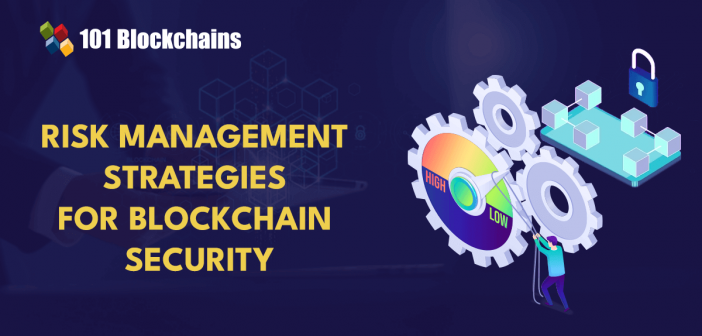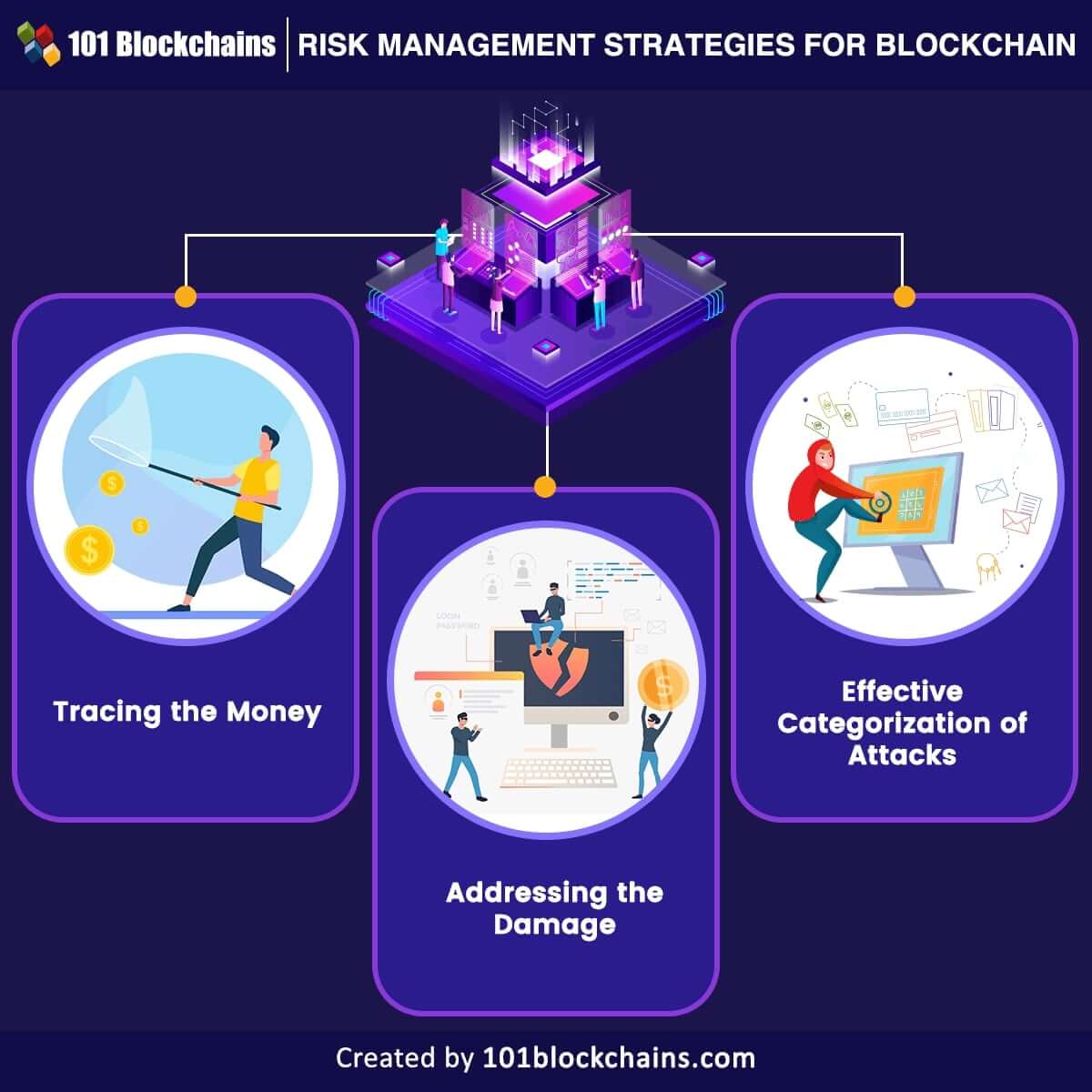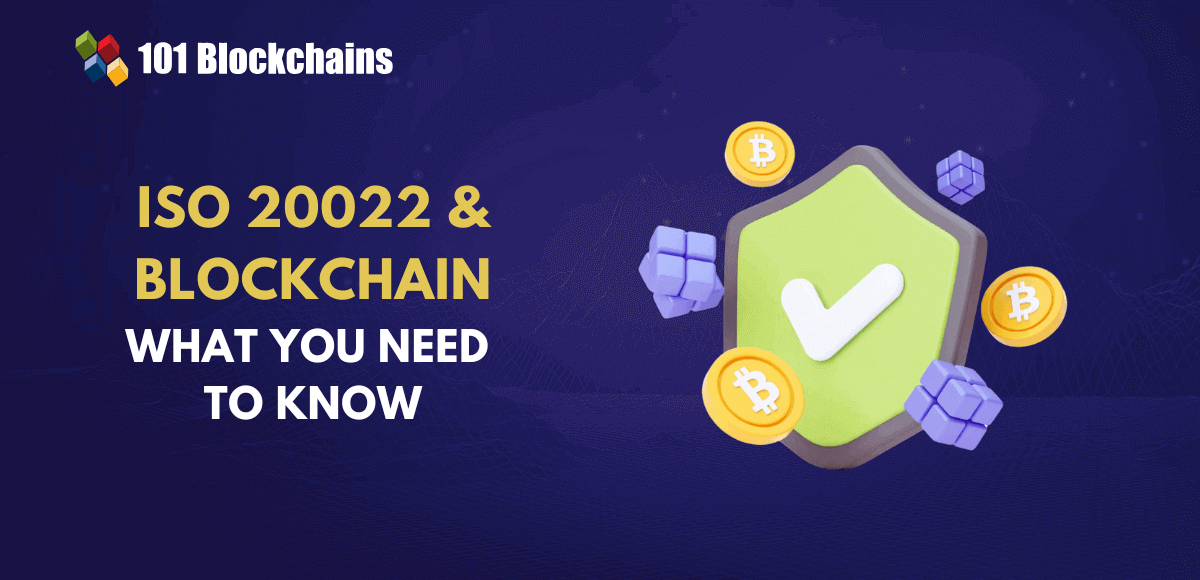Learn how blockchain truly works, master key definitions, and uncover what makes smart contracts so "smart." Dive into the fundamentals, gain valuable insights, and start your blockchain journey today!

- Blockchain
James Howell
- on December 22, 2023
Risk Management Strategies for Blockchain Security: Lessons from Incidents
The growing burden of security attacks on blockchain has become one of the notable buzzwords in the industry. It is more important than ever to address the security issues with blockchain and web3 by devising unique strategies. The detrimental consequences of blockchain security vulnerabilities have led to the rise of new safeguards against security risks. One of the most important aspects of resolving blockchain security risks is the use of risk management strategies.
The recent statistics about blockchain security incidents and continuous rise in cryptocurrency thefts are alarming indicators for the future of blockchain and web3. The most prominent target of blockchain security risks is DeFi, which has become a crucial tool for transforming financial services. Let us find out the ideal approaches for creating a blockchain security risk management strategy with lessons from notable incidents.
Fundamental Concepts for Blockchain Security
The first step for creating Risk Management Strategies for Blockchain Security involves understanding the essential concepts. You must remember that blockchain solutions are part of broader human, technological, and business systems. Blockchain solutions must also depend on connectivity, effective business processes, and users. Therefore, the security of blockchain technology directly depends on the security of other integrated systems. As of now, the hype surrounding blockchain technology has led to different views regarding blockchain security.
Some people would point out that blockchain offers the advantage of cryptography, and it is practically impossible to hack into a blockchain network. On the other hand, blockchain risks and controls also validate the other school of thought about blockchain security, which assumes that blockchain is inherently insecure.
People who believe in such ideas assume that blockchain is not the ideal choice for applications that require comprehensive privacy safeguards for individual users. However, the actual truth about blockchain security is present somewhere in the middle with reference to proactive security management. On one side, you have to worry about information security considerations while on the other, you must focus on blockchain-specific security issues.
The following aspects of cybersecurity basics could give you an ideal start for creating a blockchain security risk management strategy.
Build your identity as a certified blockchain expert with 101 Blockchains’ Blockchain Certifications designed to provide enhanced career prospects.
Security Fundamentals
You can develop better blockchain risk management strategies by understanding the fundamentals of security. First of all, you must know that security is a continuous process, and you have to stay one step ahead of the hackers at all times. Another crucial highlight in security fundamentals points at the CIA triad, which includes confidentiality, availability and integrity. The three properties help in defining the security goals. Blockchain has been tailored to achieve data integrity. However, it would have to encounter conflicts between the availability and confidentiality aspects of the CIA triad.
Want to explore an in-depth understanding of security threats in DeFi projects? Enroll now in the DeFi Security Fundamentals Course
The Relationship between Data Integrity and Immutability
The term ‘data integrity’ emphasizes the fact that data cannot be destroyed or modified in an unauthorized manner. On the other hand, immutability ensures perfection in data integrity. You can find answers to “What are the risk management strategies in blockchain?” by reflecting on the concept of defense in layers.
Design principles with multiple defense layers could prevent attackers from reaching the critical cores. You can notice the same in blockchain, which includes security controls at different checkpoints. For example, hackers would have to figure out the hash mechanism of the blocks after the block they want to compromise.
In addition, the concept of layered defense would also point to the use of virtualized private clouds for security of blockchain nodes. It can open the required ports, and access control lists can help in restricting access to smart contracts. You can develop blockchain security risk management approaches by relying on simplicity. Transparency and simplicity in security measures could help in avoiding complexities, thereby contributing to security enhancements.
Blockchain Contributions to Security
Traditional information security can offer security for the development stack involved in supporting blockchain networks. In addition, you must also know how blockchain itself could contribute to inherent security. Decentralization could help in ensuring that security is distributed across all nodes of the network and ensures distributed security governance.
The important risk management strategies for blockchain security also emphasize consensus mechanisms that ensure integrity of data on blockchain. Proof of Work and Proof of Stake are the most popular consensus mechanisms. In addition, the variations of new consensus mechanisms could offer different levels of security alongside ensuring unique prerequisites for implementation. In the case of private blockchains, teams could choose the consensus mechanism that aligns with the nature of desired solutions.
Endpoint security is also another crucial aspect of blockchain security risks and controls for an effective strategy. The removal of centralization in blockchain could draw attention to the shared responsibility model. The necessity for protecting digital access points suggests that solution providers must ensure awareness about the responsibilities of users for ensuring security. It is also important to notice the integral role of cryptographic keys in establishing the foundation of blockchain security. Cryptographic keys can be generated securely, and you can use and store them according to your preferences.
Another prominent aspect in the field of blockchain risk management points to smart contracts, which are crucial tools for ensuring data integrity. Modification of smart contracts is a challenge no one would like to take, owing to the investment of resources and associated costs. However, smart contract audits are also important for checking smart contracts to identify any potential security challenges.
Learning from the Examples of Popular Blockchain Security Incidents
The examples of different types of attacks on crypto exchanges and blockchain solutions can help in understanding blockchain security risks with a personalized viewpoint. The review of security incidents would help in identifying the ideal answers for “What are the risk management strategies in blockchain?” from practical experience. Here is an overview of the different types of security incidents that have made a mark in the domain of blockchain and web3 in the last decade.
-
Coincheck
The attack on Coincheck in 2018 resulted in a loss of $535 million due to a security breach. What was the reason for such humongous losses? Apparently, the crypto exchange stored user assets in a vulnerable hot wallet, which is always connected to the internet. Such types of hacks can damage the reputation of the organization and reduce trust in blockchain and crypto security.
-
Bitmart
Another popular example of security breaches that showcase blockchain security vulnerabilities is the attack on Bitmart in 2021. The crypto trading platform suffered from a large-scale breach, leading to a loss of $150 million. Bitmart had to endure the losses due to the security breach that resulted from the theft of private keys.
Hackers employed a systematic approach by using the aggregator of a DEX for exchanging stolen assets and used a secondary address for entering the ETH received in the sales in the Tornado Cash privacy mixer. It helped the attackers remove all traces of the stolen assets.
-
Crypto.com
One of the most popular cryptocurrency exchange companies, Crypto.com, also had to bear the brunt of a security breach in January 2022. It incurred massive losses amounting to a total of $34 million. The company noticed the security breach only after the risk monitoring systems of the company detected that some users were making unauthorized crypto withdrawals from accounts.
-
Bridge Protocol Hacks
Blockchain bridge protocols have emerged as a promising solution to the interoperability problems in the blockchain ecosystem. However, bridges have become the vulnerable targets of blockchain security risks, and controls must be implemented to ensure stronger safeguards. Blockchain bridges can allow convenient transfer of assets from one blockchain ecosystem to another without sale of cryptocurrencies.
The vulnerabilities in the protocols have led to massive losses. The Ronin Bridge hack led to financial losses amounting to almost $625 million. Within the first 8 months of 2022, bridge protocol hacks had inflicted a loss of $1.4 billion. Other notable attacks on bridge protocols include the Wormhole Bridge attack, which led to a loss of $320 million.
Enroll now in the Blockchain Scalability and Interoperability Mastery Course to learn the skills needed to develop faster, scalable, robust, and interoperable dApps.
How Can You Design Risk Management Strategies for Blockchain Security?
The examples of real incidents in blockchain security prove that web3 security revolves around making immutable commitments alongside ensuring resilience to human intervention. However, development of ideal blockchain security risk management approaches would focus on the finality aspect of transactions.
The finality of transactions implies that they are irreversible, and funds, once lost, cannot be returned. How can you design risk management strategies for countering these threats? You have to embrace a strategic approach for planning the development of risk management strategies with the following steps.

-
Tracing the Money
Attackers seek vulnerabilities in blockchain security to achieve maximum returns on their investments. Therefore, they could spend more time and effort in attacking protocols that have more value for better rewards. Some of the most well-equipped hacker groups focus on high-value systems and come up with novel exploits for attacking prized targets. On the other hand, low-cost attacks such as phishing would continue to rule the list of blockchain security risks.
-
Addressing the Damage
Developers have to observe the different blockchain security risks and controls that help ensure blockchain security by default. For example, the use of secure APIs could help in creating challenges for introducing vulnerabilities. Another important aspect of every risk management strategy for blockchain security points to the fact that nothing is completely secure. Developers and security experts have to work on improving the cost of the attacks that could dissuade attackers from deploying security breaches.
The good news for blockchain risk management strategies is the development and evolution of security practices. At the same time, the blockchain ecosystem has also witnessed the rise of multiple new tools for blockchain security. For example, smart contract audit tools are evolving with new functionalities for detecting different vulnerabilities.
On top of it, auditing tools could also flag the possibility of security issues with a severe impact. Developers could also choose mitigation efforts to reduce the possibilities of attacks on blockchain solutions. By reducing the reward for attackers, it can help in deterring attackers from exploiting blockchain projects. When hackers find that the benefits are less than the cost involved in hacking efforts, they are likely to back out.
Understand the critical vulnerabilities and security risks in smart contracts with this Smart Contracts Security Course.
-
Effective Categorization of Attacks
The most critical element of risk management strategies for blockchain security would point to the classification of attacks. Some of the noticeable traits of attacks point to the level of sophistication involved in the attacks, prevention measures suitable for defense, and extent of automation in the tasks. You can come across standard risk considerations, smart contract risk considerations, and value transfer risk considerations.
Standard risk considerations point to the effect of strategic risks, regulatory risks, contractual risks, reputational risks, and business continuity risks. In addition, you must also think about supplier risks and information security risks as prominent additions to standard risk considerations.
The noticeable smart contract risk considerations would point to business and regulatory risks, legal liability risks, information security risks, and enforcement of contract risks. You should also pay attention to the value transfer risks considerations with respect to consensus protocol risks, liquidity risks, key management risks, and data confidentiality risks.
The answers to “What are the risk management strategies in blockchain?” point to the necessity of classification of risks to establish their priority. You can identify which risks you should address first to safeguard your blockchain solutions. In addition, classification of security risks also serves as an effective approach for creating a common standard for explaining security challenges.
Conclusion
The advantages of blockchain security risk management revolve around helping blockchain solutions avoid monetary losses and damage to their reputation. Blockchain security risks can slow down the pace of web3 adoption. With so many innovative trends emerging in the blockchain ecosystem, it is reasonable to look for effective approaches that could safeguard users.
As users struggle with new challenges for blockchain security, it is important to understand how you can stay ahead of the hackers. If you can design a comprehensive blockchain security strategy with special attention to all risks, you can achieve better results for long-term adoption of blockchain solutions. Learn more about blockchain security fundamentals and find the best practices to safeguard innovative blockchain solutions.
*Disclaimer: The article should not be taken as, and is not intended to provide any investment advice. Claims made in this article do not constitute investment advice and should not be taken as such. 101 Blockchains shall not be responsible for any loss sustained by any person who relies on this article. Do your own research!







